Related Research Articles

Edward of Woodstock, latterly known as the Black Prince, was the eldest son and heir apparent of King Edward III of England. He died before his father and so his son, Richard II, succeeded to the throne instead. Edward nevertheless earned distinction as one of the most successful English commanders during the Hundred Years' War, being regarded by his English contemporaries as a model of chivalry and one of the greatest knights of his age. Edward was made Duke of Cornwall, the first English dukedom, in 1337. He was guardian of the kingdom in his father's absence in 1338, 1340, and 1342. He was created Prince of Wales in 1343 and knighted by his father at La Hougue in 1346.

Thomas Holland, 2nd Baron Holand, and jure uxoris1st Earl of Kent, KG was an English nobleman and military commander during the Hundred Years' War. By the time of the Crécy campaign, he had apparently lost one of his eyes.

Richard Fitzalan, 3rd Earl of Arundel, 8th Earl of Surrey was an English nobleman and medieval military leader and distinguished admiral. Arundel was one of the wealthiest nobles, and most loyal noble retainer of the chivalric code that governed the reign of Edward III of England.
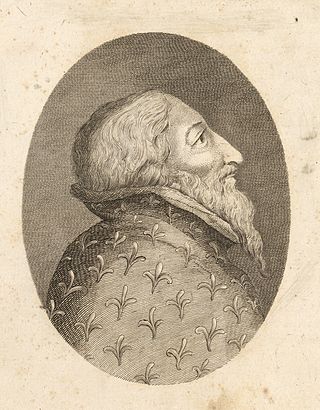
Henry Percy, 1st Earl of Northumberland, 4th Baron Percy, titular King of Mann, KG, Lord Marshal was the son of Henry de Percy, 3rd Baron Percy, and a descendant of Henry III of England. His mother was Mary of Lancaster, daughter of Henry, 3rd Earl of Lancaster, son of Edmund, Earl of Leicester and Lancaster, who was the son of Henry III.
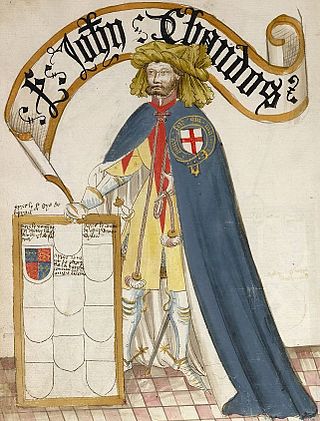
Sir John Chandos, Viscount of Saint-Sauveur in the Cotentin, Constable of Aquitaine, Seneschal of Poitou, was a medieval English knight who hailed from Radbourne Hall, Derbyshire. Chandos was a close friend of Edward the Black Prince and a founding member and 19th Knight of the Order of the Garter in 1348. Chandos was a gentleman by birth, but unlike most commanders of the day he held no inherited title of nobility.
The word seneschal can have several different meanings, all of which reflect certain types of supervising or administering in a historic context. Most commonly, a seneschal was a senior position filled by a court appointment within a royal, ducal, or noble household during the Middle Ages and early Modern period – historically a steward or majordomo of a medieval great house. In a medieval royal household, a seneschal was in charge of domestic arrangements and the administration of servants, which, in the medieval period particularly, meant the seneschal might oversee hundreds of laborers, servants and their associated responsibilities, and have a great deal of power in the community, at a time when much of the local economy was often based on the wealth and responsibilities of such a household.

Sir James Audley, KG was one of the original knights, or founders, of the Order of the Garter. He was the eldest son of Sir James Audley of Audley in Staffordshire.

The Battle of Nájera, also known as the Battle of Navarrete, was fought on 3 April 1367 to the northeast of Nájera, in the province of La Rioja, Castile. It was an episode of the first Castilian Civil War which confronted King Peter of Castile with his half-brother Count Henry of Trastámara who aspired to the throne; the war involved Castile in the Hundred Years' War. Castilian naval power, far superior to that of France or England, encouraged the two polities to take sides in the civil war, to gain control over the Castilian fleet.
Sir Geoffrey le Scrope was an English lawyer, and Chief Justice of the King's Bench for four periods between 1324 and 1338.
Sir Archibald Douglas was a Scottish nobleman, Guardian of Scotland, and military leader. He is sometimes given the epithet "Tyneman", but this may be a reference to his great-nephew Archibald Douglas, 4th Earl of Douglas. He fought and died at the Battle of Halidon Hill.

Sir Hugh de Courtenay, 2nd/10th Earl of Devon, 2nd Baron Courtenay, feudal baron of Okehampton and feudal baron of Plympton, played an important role in the Hundred Years War in the service of King Edward III. His chief seats were Tiverton Castle and Okehampton Castle in Devon. The ordinal number given to the early Courtenay Earls of Devon depends on whether the earldom is deemed a new creation by the letters patent granted 22 February 1334/5 or whether it is deemed a restitution of the old dignity of the de Redvers family. Authorities differ in their opinions, and thus alternative ordinal numbers exist, given here.
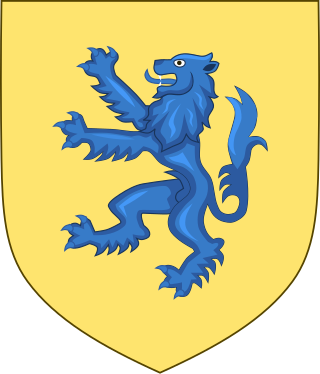
Henry Percy, 9th Baron Percy of Topcliffe, 2nd Baron Percy of Alnwick was the son of Henry de Percy, 1st Baron Percy of Alnwick, and Eleanor Fitzalan, daughter of Sir Richard FitzAlan, 8th Earl of Arundel, and sister of Edmund FitzAlan, 9th Earl of Arundel.
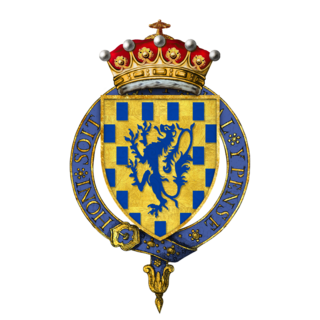
Guichard (IV) d'Angle, Earl of Huntingdon, KG was a Poitevin knight, a Knight of the Garter and a companion of Edward the Black Prince. He was born in a noble family from Angles-sur-l'Anglin in North-Eastern Poitou, sometime between 1305 and 1315.

Baron Everingham is an abeyant title in the Peerage of England. It was created by Writ of summons to Parliament of Adam de Everingham of Laxton, Nottinghamshire, on 4 March 1309. It passed to his son Adam but fell into abeyance upon the death of his childless grandson Robert in 1371.

Sir Thomas de Felton was an English landowner, military knight, envoy and administrator. He fought at the Battle of Crécy in 1346, and the Capture of Calais in 1347. He was also at the Battle of Poitiers in 1356. A recurrent figure in the Chronicles of Jean Froissart, he was a signatory to the Treaty of Brétigny in 1360. In 1362 he was appointed Seneschal of Aquitaine. He accompanied Edward the Black Prince on his Spanish campaign. He was taken prisoner by Henry of Trastámara's forces in 1367. In 1372 he was appointed joint-governor of Aquitaine and seneschal of Bordeaux. He caused Guillaume de Pommiers and his secretary to be beheaded for treason in 1377. He was invested a Knight of the Garter in 1381.
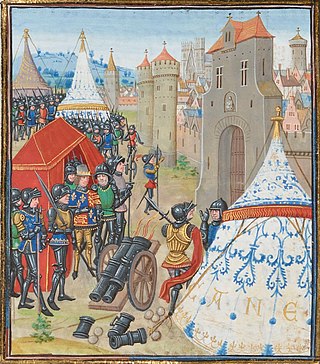
The Reims campaign took place during the Hundred Years' War. It occurred after the French de facto government rejected the terms of the Treaty of London and consequently Edward III of England organised and commanded an expeditionary army to gain by force what he had failed to win by diplomacy. On 28 October 1359 Edward landed at Calais, and advanced to Reims, where he hoped to be crowned king of France. The strenuous resistance of the citizens frustrated this scheme, and Edward marched into Burgundy, and then he made his way back towards Paris. Failing in an attack on the capital, he was glad to conclude, on 8 May 1360, preliminaries of peace at Brétigny, near Chartres. This treaty, less onerous to France than that of London, took its final form when Edward and John ratified the treaty in Calais on 9 October 1360. By it Edward renounced his claim to France in return for Aquitaine and other French territories in full sovereignty.
The Seneschal of Gascony was an officer carrying out and managing the domestic affairs of the lord of the Duchy of Gascony. During the course of the twelfth century, the seneschalship also became an office of military command. After 1360, the officer was the Seneschal of Aquitaine. There was an office above the seneschalcy, the Lieutenancy of the Duchy of Aquitaine, but it was filled only intermittently.
The Seneschal of Poitou was an officer carrying out and managing the domestic affairs of the lord of the County of Poitou. During the course of the twelfth century, the seneschalship, also became an office of military command.

Sir Robert de Ogle was an English soldier and feudal landowner in Northumbria who fought in the border conflicts with Scotland. He captured five Scottish knights near Newcastle in 1341 and was licensed to crenellate Ogle House. He distinguished himself in resisting the foray into Cumberland of Sir William Douglas in 1345, fought at Neville's Cross in 1346 and took three nobles prisoner, and held Berwick Castle against the Scots in 1355.

The Felton family, also known as de Feltone, is a minor Anglo-Norman noble dynasty, originating in Northumberland, near the village of Felton. Many of its members served as seneschals and castellans throughout the Medieval period, from the Norman Conquest onward. The Feltons had numerous peerages and titles throughout the centuries, most recently the baronetcy of Playford.
References
- C.R. (1993), "Felton, Sir John (c.1339-1396), of Edlingham, Northumb.", in Roskell, J.S.; Clark, L.; Rawcliffe, C. (eds.), The History of Parliament: the House of Commons 1386-1421, Boydell and Brewer
Attribution:
 This article incorporates text from a publication now in the public domain : Fotheringham, James Gainsborough (1889), "Felton, William (d.1367)", in Stephen, Leslie (ed.), Dictionary of National Biography , vol. 18, London: Smith, Elder & Co, p. 311 endnotes:
This article incorporates text from a publication now in the public domain : Fotheringham, James Gainsborough (1889), "Felton, William (d.1367)", in Stephen, Leslie (ed.), Dictionary of National Biography , vol. 18, London: Smith, Elder & Co, p. 311 endnotes: - Suffolk Institute of Archæology, iv. 27;
- Dugdale's Baronage, ii. 64;
- Rymer's Fœdera; Froissart's Chroniques, ed. Luce;
- Anselme, Maison Royale de France;
- Chandos Herald, Life and Feats of Arms of Edward the Black Prince;
- Ayala, Crónica del Rey Don Pedro, included in Crónicas de los Reyes de Castilla, Madrid, 1875